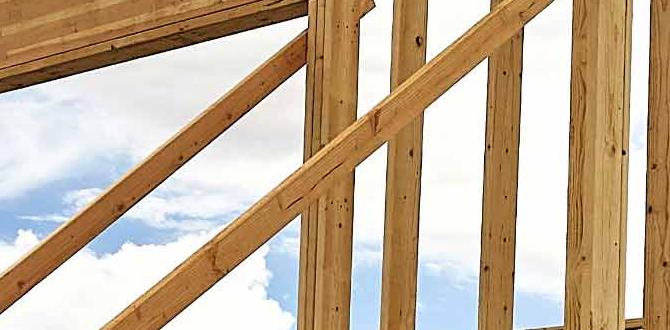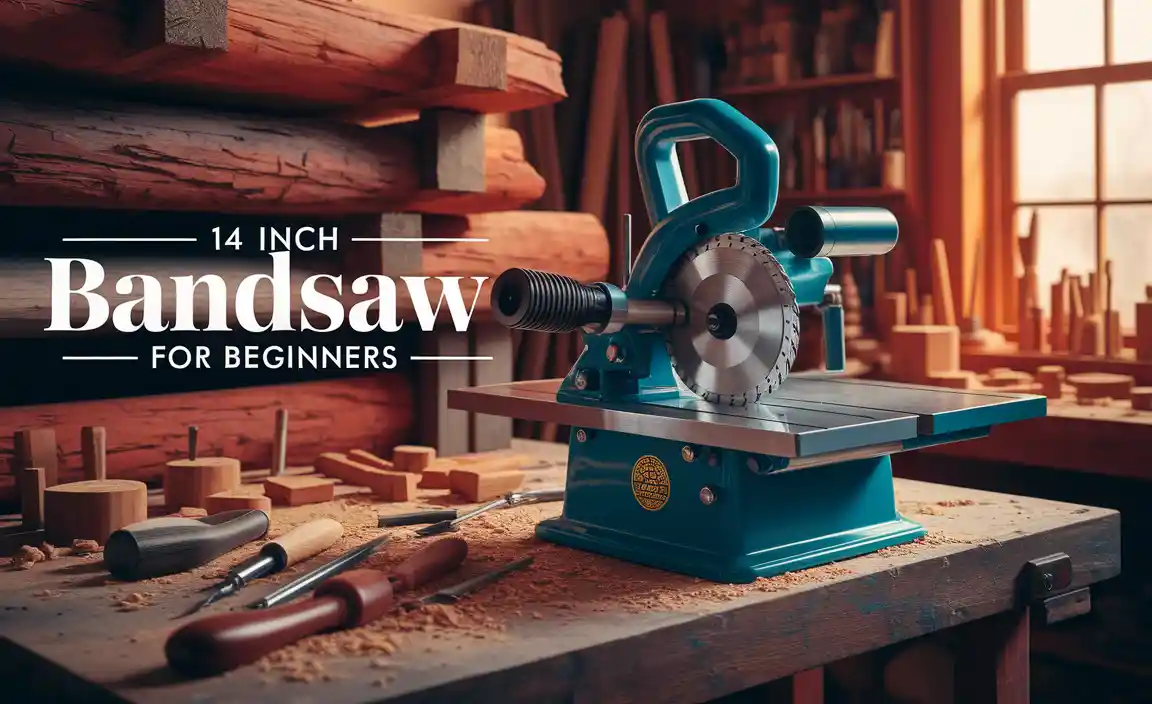Use a nail gun for wainscoting to achieve a professional, seamless finish quickly and easily. Our guide simplifies the process, ensuring beginners can confidently install beautiful wainscoting with the right tools and techniques for a stunning home upgrade.
Wainscoting can transform a room, adding classic style and elegance. But let’s be honest, nailing it all by hand? That sounds like a recipe for sore arms and uneven lines. If you’ve ever felt intimidated by DIY projects that require precision and a lot of fasteners, you’re not alone. Many homeowners dream of wainscoting but worry about the installation. The good news is, there’s a tool that makes this project not just manageable, but genuinely enjoyable: a nailer! In this guide, we’ll walk you through, step-by-step, on how to use a nailer for wainscoting, turning a daunting task into a rewarding accomplishment. Get ready to bring that designer look to your home with confidence and ease.
Table of Contents
Why a Nailer is Your Wainscoting Best Friend
When it comes to installing wainscoting, precision, speed, and a clean finish are key. While it’s technically possible to use a hammer and nails, a nailer offers undeniable advantages that make it almost essential for this type of project. Think of it as your secret weapon for achieving professional-looking results without the professional price tag or the painstaking labor.
Speed and Efficiency
Manually hammering each nail takes time. For wainscoting, which often involves dozens, if not hundreds, of nails, this can add hours to your project. An electric or pneumatic nailer drives nails precisely and instantly with the pull of a trigger. This dramatically speeds up the installation process, allowing you to complete your wainscoting project in a fraction of the time it would take with a hammer. This means less time on your knees and more time enjoying your newly updated space!
Consistency and Precision
Achieving perfectly straight and evenly spaced wainscoting panels requires consistent depth and placement of nails. A nailer allows you to set a consistent depth, ensuring nails penetrate the wood without over-driving (which can split the wood or leave unsightly divots) or under-driving (leaving nails sticking out). This consistency is crucial for a smooth, professional look. Furthermore, the pinpoint accuracy of a nailer helps you hit your mark every time, reducing the chance of accidental damage to the surrounding wall or the wainscoting itself.
Less Damage, Better Finish
Hammering can sometimes lead to accidental dents or gouges on the wood surface from missed swings or glancing blows. A nailer, when used correctly, minimizes this risk. The controlled impact ensures the nail is driven straight, and the nose of the nailer guides its placement. This results in a cleaner aesthetic with less need for extensive touch-ups. Your wainscoting will look pristine, as if it was installed by a seasoned pro.
Reduced Fatigue
Let’s not forget the physical toll. Repeatedly swinging a hammer, especially overhead or in awkward positions, can be exhausting. A nailer significantly reduces the physical strain. The simple act of squeezing a trigger is far less demanding than swinging a hammer. This means you’re less likely to get tired, make mistakes due to fatigue, or strain yourself. You can work more comfortably for longer periods, which is a huge plus for any DIYer.
Choosing the Right Nailer for Wainscoting
Not all nailers are created equal, and for wainscoting, a few types stand out as ideal. The biggest decision usually comes down to power source: pneumatic or electric. Let’s break down the best options:
1. Brad Nailer
Why it’s great for wainscoting: A brad nailer is the go-to choice for trim and molding work, and wainscoting is no exception. It fires thin, headless nails (brads) that are perfect for securing delicate trim pieces without splitting the wood or leaving large holes. These nails are easy to conceal with wood filler or paint. Brad nailers are also relatively lightweight and easy to maneuver.
- Common Nail Sizes Used: 18-gauge brad nailers are the most popular for wainscoting. They shoot nails typically ranging from 5/8 inch to 2 inches.
- Power Source Options:
- Pneumatic (Air-Powered): These require an air compressor and air hose. They are generally lighter than electric models, offer more power, and are favored by professionals for continuous use.
- Cordless Electric (Battery-Powered): These are incredibly convenient as they don’t require a hose or compressor. They use batteries for power, offering great portability. Newer models are powerful enough for most wainscoting tasks.
- Corded Electric: These plug directly into an outlet. They are usually the most affordable option and offer consistent power without worrying about battery life, but you’re tethered by the cord.
2. Finish Nailer
Why it’s a solid alternative: A finish nailer fires slightly larger nails (typically 15 or 16-gauge) than a brad nailer. These nails offer a bit more holding power, which can be beneficial for thicker wainscoting profiles or if you want extra security. The holes left by finish nails are a bit more noticeable than brad nail holes, but still easily managed with wood filler.
- Common Nail Sizes Used: 15-gauge and 16-gauge finish nailers. Nails range from 1 ¼ inch to 2 ½ inches.
- Power Source Options: Similar to brad nailers: pneumatic, cordless electric, and corded electric.
What to Consider When Choosing:
For most DIY wainscoting projects, an 18-gauge cordless brad nailer is the ultimate combination of convenience, power, and suitable fastener size. If you already own an air compressor, a pneumatic brad nailer is also an excellent and often more budget-friendly choice.
Pro Tip: Always check the recommended nail size for your specific wainscoting material. Thinner, softer woods may require smaller gauge nails to prevent splitting, while denser, thicker materials might benefit from the slightly larger diameter of finish nails.
Essential Tools and Materials for Wainscoting Installation
Before you fire up that nailer, gather all your supplies. Having everything on hand will make the installation process smooth and efficient. Think of this as your pre-flight checklist!
Here’s what you’ll need:
- Your chosen wainscoting panels (e.g., beadboard, shaker style, picture frame molding)
- Measuring tape
- Pencil
- Level (4-foot is ideal)
- Miter saw (for straight cuts and angled cuts on trim/molding)
- Jigsaw (for cutting around outlets or windows if needed)
- Your nailer (brad or finish) and the appropriate size nails
- Air compressor and hose (if using a pneumatic nailer)
- Safety glasses (ESSENTIAL!)
- Hearing protection (especially with pneumatic nailers)
- Wood glue
- Sandpaper (various grits, e.g., 120, 150, 220)
- Wood filler or putty
- Putty knife or Spackle knife
- Caulk gun and paintable caulk
- Paint or stain and brushes/rollers
- Stud finder
- Optional: Coping saw (for traditional picture frame wainscoting joints)
Step-by-Step: How to Use a Nailer for Wainscoting
Ready to install? Follow these steps carefully, and you’ll be amazed at the results. Safety first, always!
Step 1: Plan Your Layout and Mark Your Lines
This is where the magic starts to take shape. Decide on the height of your wainscoting and where it will begin and end on your walls. Use your measuring tape and pencil to lightly mark the top and bottom lines of your wainscoting on the wall. A level is your best friend here to ensure your lines are perfectly straight.
- Measure the height you want your wainscoting to be. Common heights are 32 inches, 36 inches, or 48 inches.
- Use your level to draw a horizontal line around the room at your desired height. This will be your guide for the top of the wainscoting panels.
- If you’re installing a chair rail or a baseboard, mark those lines too.
Important Note: Use a stud finder to locate wall studs along your marked lines. Nailing into studs provides the most secure hold. You’ll want to mark the center of each stud along your line or within the area where your wainscoting will be installed. This is crucial for ensuring your wainscoting stays put for years to come.
Step 2: Prepare Your Wainscoting Panels
If your wainscoting requires cutting (most do!), measure and cut your panels to fit the lengths of your walls. Remember to account for corners and any obstacles like windows or doors.
- Measure the length of each wall section where wainscoting will be installed.
- Use your miter saw to make precise cuts. For inside and outside corners, you’ll likely need to cut angles (miters) to ensure a tight fit. For standard beadboard or paneling, straight cuts are usually sufficient for the main panels.
- If you are building frame-and-panel style wainscoting, you’ll be cutting individual stiles, rails, and panels.
- Safety First: Always wear safety glasses when operating a saw.
Step 3: Dry Fit and Adjust
Before you start nailing, it’s a great idea to hold your cut pieces up to the wall to see how they look. This is your chance to make any minor adjustments to cuts, angles, or fitting. Ensure everything aligns with your marked lines and fits snugly against the wall.
Step 4: Load Your Nailer and Set Depth
Now it’s time for the nailer! Ensure you have the correct size brad or finish nails loaded into your nailer. If you’re using a pneumatic nailer, connect your air hose and ensure the compressor is at the recommended pressure (typically 70-100 PSI, check your nailer’s manual).
Crucial Step: Setting Nail Depth. This is vital for a clean finish. You want the nail head to be slightly countersunk, just below the surface of the wood, so it can be easily filled. Test fire your nailer on a scrap piece of the same wood you’re using for your wainscoting.
- Start with a medium depth setting.
- Fire a nail into the scrap wood.
- Examine the result:
- Too deep: The nail head is buried too far, potentially damaging the wood. Reduce the depth setting.
- Too shallow: The nail head is sticking out. Increase the depth setting.
- Just right: The nail head is slightly below the surface. This is your setting!
Once you have your depth set perfectly, you’re ready to start attaching your wainscoting.
Step 5: Nailing the Wainscoting Panels
This is the core of the installation. Position your first wainscoting panel against the wall, aligning it with your marked lines. For optimal strength, aim to nail into the wall studs whenever possible, which you marked earlier.
- Positioning is Key: Place the nailer’s nose against the surface of the wainscoting where you want to drive a nail.
- Angle for Strength: For a strong hold, consider angling your nails slightly, especially when nailing into studs. This technique, known as toenailing, helps secure the wood firmly. You can also try to place nails where panels overlap.
- Nail Spacing: For standard panels, place nails every 12-16 inches along the length of the panel, and also near the top and bottom edges. If you have a top trim piece (like a chair rail), nail through the panel into the wall below where the chair rail will cover. Many beadboard panels have tongue-and-groove edges; nail along the tongue where it meets the wall stud.
- Trigger and Fire: Press the safety contact tip of the nailer firmly against the wood, then squeeze the trigger. Hold the nailer in place for a moment to ensure the nail drives fully.
- Work Your Way Around: Continue attaching panels, ensuring they are flush against the wall and aligned with your marks. Use your level frequently to ensure straightness.
- Applying Wood Glue: For added strength, you can apply a thin bead of wood glue to the back of the wainscoting paneling or where panels meet before nailing. Wipe away any excess glue immediately with a damp cloth.
Safety Reminder: Always keep your fingers away from the nail exit point and never point the nailer at yourself or others. Wear your safety glasses at all times!
Step 6: Install Top and Bottom Trim (Chair Rail/Baseboard)
Once your main wainscoting panels are securely attached, it’s time to add the finishing touches. This typically involves a top trim piece (like a chair rail) and often a baseboard. These pieces hide the top and bottom edges of your wainscoting.
- Measure and cut your trim pieces, using angled cuts (miters) for corners and joints.
- Position the trim against the wall and wainscoting.
- Use your nailer (a brad nailer is ideal here for its discreet nail size) to attach the trim. Aim to nail into studs or wall plates for the best hold.
- Nail the trim every 12-16 inches.
Step 7: Fill Nail Holes and Caulk
This step is crucial for achieving a seamless, professional finish. All those nail holes need to be addressed.
- Fill the Holes: Use wood filler or putty that matches your wood color (if painting) or stain color. Apply a small amount to each nail hole using a putty knife or your finger. Scrape away any excess so it’s flush with the wood surface. Allow the filler to dry completely according to the product instructions.
- Sand Smooth: Once the filler is dry, lightly sand each filled spot until it’s smooth and flush with the surrounding wood. You can then do a light overall sanding of the wainscoting and trim with 220-grit sandpaper to prep for finishing.
- Caulk Gaps: Apply a thin bead of paintable caulk along the top edge where the wainscoting meets the wall, and along the bottom edge where it meets the baseboard (if you didn’t install a baseboard and it meets the floor). Also, caulk any gaps between panels or trim pieces. Smooth the caulk line with a damp finger or caulk tool.
Step 8: Sand, Prime, and Paint/Stain
Now for the final aesthetic transformation! Once all the filler and caulk are dry and smooth:
- Lightly sand the entire wainscoting area again with fine-grit sandpaper (220). Wipe away all dust with a tack cloth or a slightly damp cloth.
- Apply a coat of primer. This is especially important if you’re painting.
- Once the primer has dried, apply your chosen paint or stain. You may need two coats for full coverage.
- Allow the finish to cure completely before placing furniture back against the walls or heavy use.
Wainscoting Nailer Dos and Don’ts
Here’s a quick rundown of best practices to ensure your wainscoting project goes off without a hitch:
| Do | Don’t |
|---|---|
| Wear safety glasses AT ALL TIMES. | Ever point your nailer at yourself or others. |
| Use the correct gauge and length nails for your wainscoting. | Use a nailer in wet or extremely dusty conditions without checking its specifications. |
| Test your nail depth on scrap wood first. | Force a nail if the nailer jams; follow the manual’s clearing instructions. |
| Nail into wall studs for maximum holding power. | Overdrive nails, as this can damage the wood surface. |
| Keep the nailer’s air pressure within the recommended range (for pneumatic). | Forget to disconnect the air hose or remove the battery when not in use or stored. |
| Regularly clean and maintain your nailer according to the manufacturer’s instructions. | Rush the process; precision is key for a great finish. |
Troubleshooting Common Wainscoting Nailer Issues
Even with the best intentions, you might run into a hiccup. Here are some common nailer issues and how to




